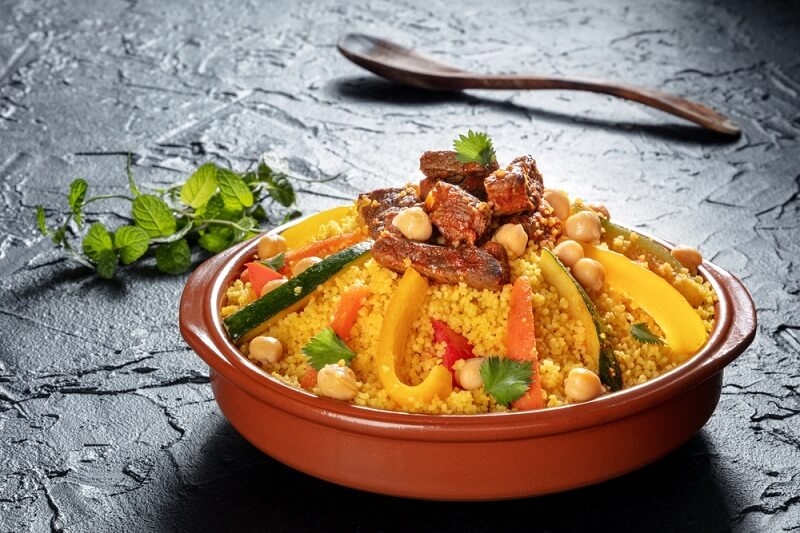
Algerian couscous embodies more than a dish. It is an integral part of the Algerian heritage, connecting families and generations. Couscous embodies the essence of national identity and tradition. It is one of the most popular dishes in North African cuisine, featuring couscous. Couscous represents comfort food, hospitality, and the dueling art of sharing food and eating together.
Whether preparing couscous in a simple home kitchen or for significant communal events, couscous is a culinary experience in Algeria that can engage the heart and mind in ways that foster understanding and appreciation.
Couscous is a fundamental part of Algerian foodways and embodies familial connection and special occasions. The couscous tradition is passed down within families, with the recipe held sacred and often only explored by the next generation. The dish is typically served during special events, such as weddings, religious observances, and community gatherings.
The couscous tradition embodies Algerian values of care, solidarity, and appreciation through food.
All recipes for couscous in Algeria begin with the same ingredients: steamed grains of semolina, vegetables, and meat. What makes Algerian couscous special is the balancing of flavors and spices, ultimately distinguishing one couscous from another.
Examples of Ingredients:
A classic couscous recipe in Algeria relies on balance. One spice never overpowers another. The result is so hearty, fragrant, and delicious.
In Algeria, couscous comes in several lovely incarnations, each showcasing the local ingredients and the artistry of the people. These varieties abound, both savory and sweet, and are flexible enough to fit anyone's palate.
Each of these versions of couscous describes the origin of the ingredient, its local adaptation, and the people's love of finishing their plates with a robust flavor. Each plate, spicy or mild, feeds the love of Algeria's culinary imagination!

Making couscous at home requires skill and patience. While store-bought pre-steamed couscous is easy and convenient, the proper method requires 2-3 back-and-forth steamings of the grains to achieve the authentic texture and flavor.
How to make homemade couscous—step-by-step:
This method captures the essence of making couscous at home: warmth, smell, and the act of doing these steps.
Couscous is not just reserved for special occasions in Algeria; it is an everyday food. Many Algerians will take a small portion for lunch or dinner, or at least on weekends. There are also street markets that will sell you ready-made couscous. Many people also make couscous at home for family dinners.
What makes couscous soothing is that it can adjust to every mood; it can be light and simple on a day-to-day basis or rich and indulgent around special occasions. This versatility maintains Algerian couscous as a relevant food product in contemporary kitchen settings, and the shape of its very foundation—traditional couscous —remains unchanged.
Although there are different styles of couscous in each North African country, North African couscous is underpinned by a standard culinary narrative that unites them. The flavors and variations of sauces in Algerian couscous are the most distinctive, but ultimately, they are all part of a regional meta-identity that also includes Tunisia and Morocco.
This sense of regional belonging puts North African couscous not just as a dish but as a cultural tributary unifying disparate communities.
Couscous is more than simply mashed-up grains and the flavor of the dish; it embodies Algeria’s values of family, respect, and hospitality. The significance of making couscous with loved ones—shaping balls of grain by hand, exchanging life stories, and serving their meals—has as much value, if not more than, the act of eating couscous itself. Many homes will have the elders teaching the younger generations how to prepare couscous correctly, honoring the art of making couscous.
The act of cooking becomes a means of storytelling, where memories, personality, and emotions are embodied in every grain of couscous. Today, serving a dish of couscous to guests demonstrates genuine kindness and warmth. This practice has become evidence that food, not only couscous, continues to be Algeria's universal language of love and compassion.
Few dishes portray Algeria's history, geography, and spirit better than couscous. It has Berber roots and has long been a culinary cornerstone of family life; to this day, it continues to provide continuity and comfort for thousands of Algerians. It is simple, the grains of semolina elevated by spices, loneliness, and love. It represents the Algerian spirit: everyday ingredients transformed into something deeply special by people with passion and belief. To truly understand Algeria's cuisine, one must try the national dish, couscous. A taste offers a morsel of Algeria's heart—earthy, warm, alive.
Algerian couscous is more than food—it’s a living symbol of family, culture, and unity. Each Algerian couscous recipe embodies centuries of tradition, while the various couscous varieties showcase creativity and diverse flavors. Whether enjoying homemade couscous or regional versions, one thing is sure—this North African classic continues to define Algeria’s heart and heritage.
This content was created by AI